Tom Parkinson's monthly column, introducing the diverse range of flora and fauna on show at Sanctuary Lakes.
A walk around Sanctuary Lakes’ northern border - Skeleton Creek is not only the perfect way to stretch your legs but also a chance to enjoy meadow like moments and view the diverse, abundant local flora and fauna. In under an hour and a half you can stroll from Point Cook Road to Cheetham Wetlands taking the northern Altona Meadows trail and then circling round the Sanctuary Lakes Seabrook trail on the southern side of the Creek.
There are numerous tales on the source of the name Skeleton. They range from the obvious; an early pastoralist’s named Skeleton’s farm bordered the creek, through to the natural; when the creek dried in summer the muddy cracks gave an illusion of rib, leg and arm bones, to the morbid; an early colonialist mother and son drowned in the creek and within days all that remained was their skeletons. Whatever the truth, by the 1840s maps of the district bore the name Skeleton Water Holes. The early pioneers noticed that in the dry season there were still sizable ‘holes’ of water, hence the name waterholes. In fact the Creek does link a series of Basalt Rock springs starting at Mount Cottrell and running through Truganina, Tarneit and Hoppers Crossing into Cheetham Wetlands between Altona Meadows and Sanctuary Lakes.
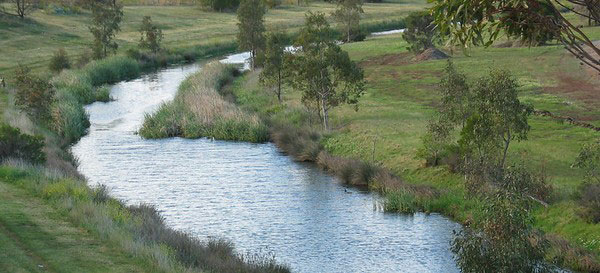 A bend in the creek
A bend in the creek 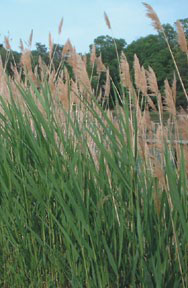 Common Reed (Phragmites Australis) Accompanying me on my mid-winter stroll were two Friends of Skeleton Creek, Denice and John. Friends of Skeleton Creek are a local social group that seeks to protect the bio-diversity and revegetate the environment along Skeleton Creek.
Common Reed (Phragmites Australis) Accompanying me on my mid-winter stroll were two Friends of Skeleton Creek, Denice and John. Friends of Skeleton Creek are a local social group that seeks to protect the bio-diversity and revegetate the environment along Skeleton Creek.
The Creek and its surrounds are alive with fauna including innumerable bird species, mammals, possums to water rats and amphibians, frogs and lizards. But for this edition I am concentrating on the Creek's wonderful array of popular native flora and therefore I have to start with the Common Reed Phragmites Australis.
The Common Reed is an essential plant for waterways, a vital contributor to control a creek's erosion and a major assistant to pollution abatement. They also provide important habitat for birds and other native fauna. The Common Reed is a tall, perennial grass that can grow to heights of four metres. Broad, pointed leaves arise from the thick, vertical stalks. Flowering occurs from December to March. The flower heads are dense, fluffy, grey or purple in colour 15-40 cm long. In autumn the plant turns brown, and the inflorescences persist throughout the winter. All that said there is a major problem with the Common Reed. In suitable habitat it increases its numbers very rapidly and can overrun a waterway within a few years. Fortunately the Friends, with help from Melbourne Water, are successfully controlling the Common Reed's enthusiasm for expansion and yet, still presenting a healthy waterway.
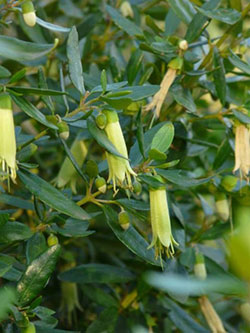 Correa Rock Correa Glabra There are two native shrubs that are easy to recognise which are establishing themselves along the Trail; Correa Rock Correa Glabra and the Coast Flax Lilly Dianella brevicaulis.
Correa Rock Correa Glabra There are two native shrubs that are easy to recognise which are establishing themselves along the Trail; Correa Rock Correa Glabra and the Coast Flax Lilly Dianella brevicaulis.
Named after the Portuguese Botanist Jose Correa da Serra, the Correa Rock is a dense 2-3 metre high shrub with dark green foliage and immediately recognisable by its distinctive tubular horn shaped lemon yellow flowers, that start to appear in April and May and then sporadically throughout the year. This very long flowering season and security of the nectar source (the tubular flower prevents nectar from being diluted or washed out by rain) makes the Correa Rock shrubs the place to be for local honey-eaters such as the Yellow Tailed Thorn Bill and the New Holland Honeyeater.
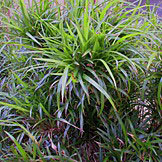 Coast Flax Lilly Dianella brevicaulis Coast Flax-lily is a tufted, perennial herb with fibrous roots and blue-purple flowers. Its leaves, up to 0.5 m in height, form a soft tussock which conceals the flowering stems. The erect, strap-like foliage, can vary in shades of grey to green. The blue flowers with bright yellow stamens, appear on spikes from late winter through to early summer and are followed by fleshy berries that can be varying shades of cobalt blue through to purple. The local Rosellas and Wattle birds seek out the tasty fruit and noisily enjoy dining on them.
Coast Flax Lilly Dianella brevicaulis Coast Flax-lily is a tufted, perennial herb with fibrous roots and blue-purple flowers. Its leaves, up to 0.5 m in height, form a soft tussock which conceals the flowering stems. The erect, strap-like foliage, can vary in shades of grey to green. The blue flowers with bright yellow stamens, appear on spikes from late winter through to early summer and are followed by fleshy berries that can be varying shades of cobalt blue through to purple. The local Rosellas and Wattle birds seek out the tasty fruit and noisily enjoy dining on them.
Besides the shrubs, there are numerous splendid tree specimens growing along the Creek and between the Trails. Two of the most plentiful and easy to recognise are the Black Wattle Acacia Mearnsii and River Red Gums Eucalyptus Camaldulensis.
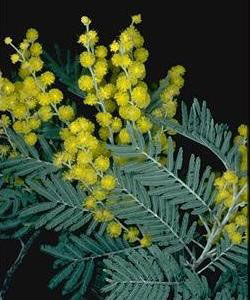 Black Wattle Acacia Mearnsii Why choose the Black Wattle, another boring soft green fern leafed, bush sized Acacia that blooms with sweetly scented intense yellow flowers between October and December? It may indeed be common, but it deserves respect. Firstly and very importantly they play a critical part in the natural regeneration and soil erosion of the Australian bush. Their expansive root systems binds the erosion prone soil and the nodules of the rhizobia bacteria present in their roots, fixes the atmospheric nitrogen into the surrounding earth. On the Black Wattle’s trunk, the cracks and crevices in the bark, becomes the home for many insects and invertebrate. Black cockatoos love the grubs (wood moths etc.) in the bark and voraciously strip the bark for access to these borers. Early last century the Tannin industry extracted 45% of its Tannic Acid from the Black Wattles bark. And if that’s not enough for respect, you can make a bushrangers thirst quenching cocktail by dissolving the Sap in water with a dash of sweet wattle flower nectar and a few formic ants for a lemony flavour, an absolute treat, although I must admit I haven’t had the courage to try it.
Black Wattle Acacia Mearnsii Why choose the Black Wattle, another boring soft green fern leafed, bush sized Acacia that blooms with sweetly scented intense yellow flowers between October and December? It may indeed be common, but it deserves respect. Firstly and very importantly they play a critical part in the natural regeneration and soil erosion of the Australian bush. Their expansive root systems binds the erosion prone soil and the nodules of the rhizobia bacteria present in their roots, fixes the atmospheric nitrogen into the surrounding earth. On the Black Wattle’s trunk, the cracks and crevices in the bark, becomes the home for many insects and invertebrate. Black cockatoos love the grubs (wood moths etc.) in the bark and voraciously strip the bark for access to these borers. Early last century the Tannin industry extracted 45% of its Tannic Acid from the Black Wattles bark. And if that’s not enough for respect, you can make a bushrangers thirst quenching cocktail by dissolving the Sap in water with a dash of sweet wattle flower nectar and a few formic ants for a lemony flavour, an absolute treat, although I must admit I haven’t had the courage to try it.
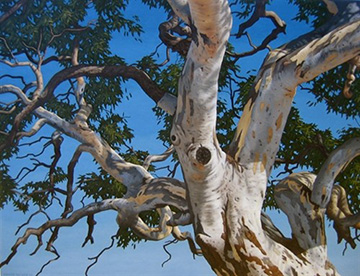 River Red Gum Eucalyptus camaldulensis At regular intervals along the Creek are those great iconic Australian trees, the River Red Gums Eucalyptus Camaldulensis. Although not as mature as the specimens in Sanctuary Lakes’ entrance, they are displaying a youthful magnificence. Red Gums will grow to over 35 metres high and have the most widespread natural distribution of any eucalypt species in Australia, providing the structural and functional elements for our wetland ecosystems. River Red Gums also provide vital refuge in the form of habitat and food resources for a whole host of birds, mammals, insects and even amphibians. They are an essential key for the bio-diversity of our waterway Skeleton Creek.
River Red Gum Eucalyptus camaldulensis At regular intervals along the Creek are those great iconic Australian trees, the River Red Gums Eucalyptus Camaldulensis. Although not as mature as the specimens in Sanctuary Lakes’ entrance, they are displaying a youthful magnificence. Red Gums will grow to over 35 metres high and have the most widespread natural distribution of any eucalypt species in Australia, providing the structural and functional elements for our wetland ecosystems. River Red Gums also provide vital refuge in the form of habitat and food resources for a whole host of birds, mammals, insects and even amphibians. They are an essential key for the bio-diversity of our waterway Skeleton Creek.
I seem to have just scratched the surface of the flora that can be seen on a stroll along the Creek. Do try it, you won't be disappointed. If you are of a mind to join an active local social environment group, why not contact the Friends of Skeleton Creek at This email address is being protected from spambots. You need JavaScript enabled to view it.